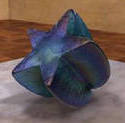|
|
|
 xRobert Richmond xRobert Richmond |

|
| Light Field Mapping - An In-Depth Analysis |
|
|
Introduction
Intel recently announced the availability of a new imaging technique to render photo-realistic three-dimensional
scenes through an advanced light reflective graphics routine known as Light Field Mapping. LFM represents
a new milestone in computer rendering technology, even though the actual development program is essentially in
its early stages. LFM is available for both synthetic and real-world image rendering, thus the underlying
algorithm can offer benefits to both gamers and design professionals. While information about Light Field
Mapping still remains limited at best, Romulus 2 has sorted through the myriad of Intel technical documents and
visual presentations to offer in-depth analysis of new technology. |
|
|

|
| Contents |
| Page One: |
Applications of Light Field Mapping
Synthetic Imaging
Real-World Imaging
Technical Analysis |
Page Four: |
Triangle Centered Approximation
Triangle-Centered Light Field Mapping
Analysis of Triangle-Centered Approximation |
| Page Two: |
Data Acquisition
Resampling and Normalization |
Page Five: |
Vertex-Centered Approximation
Vertex-Centered Light Field Mapping
Analysis of Vertex-Centered Approximation |
| Page Three: |
Surface Light Field Approximation |
Page Six: |
Hardware Acceleration
Light Field Map Compression
Final Thoughts |
|

|
|
Preview clip of a software model
using Light Field Mapping
|
|

|
|
Applications of Light Field Mapping
Three-dimensional animated models are often used to develop the amazing special effects witnessed in the majority
of today's movies. Countless hours and days are usually required to render just a few seconds of this enhanced
video using even the most powerful graphics workstations currently available. Worse yet, the software needed
to design and compile these clips generally costs many thousands of dollars and often requires expensive proprietary
hardware for proper operation.
Light Field Mapping is being developed from an alternative standpoint, with real-world performance while retaining
maximum image quality being the predominate concern. LFM is essentially a mapping routine that overlays complex
multi-variable lighting and shading algorithms upon textured surfaces in hopes of creating a more realistic image
that represents the actual model being rendered. LFM has a distinct advantage over current software techniques,
as the process can be hardware accelerated to achieve real-time performance through 3D hardware, offering traditional
multi-texturing support.
Intel will be working closely with a variety of software developers throughout the upcoming 18 to 24 months to
introduce Light Field Mapping into a variety of games and professional applications. The gaming community
will probably be the first to experience LFM imaging, though other projects are being developed as well.
Intel hopes to deploy technologies based upon LFM within consumer-oriented 3D scanning products for the retail
market segment, perhaps as early as 2004.
Synthetic Imaging






Real-World Imaging






Technical Analysis
The technical foundation of Light Field Mapping lies within the mathematical computation of a light field model
through a comparative sampling and quantification of associated geometric data for a given texture-mapped blend
operation. The primary goal is to sustain maximum image quality while employing rendering approximation through
truncation to compress the final scene into a data set sufficiently small enough to be processed by current generation
graphics hardware in a real-time fashion. While compression does lend to a rise in probable error rate, the
final image is generally of superior enough precision and accuracy to retain superb results for sustained photo-realistic
retinal recomposition within a proportionate visual perception range. Further discussion of Light Field Mapping
will employ extended mathematical representations which utilize several fundamentals of both trigonometry and calculus. |
| |
Page Two . . .
|
| |
|
|
Back to Top
|
| |
|
|
|

